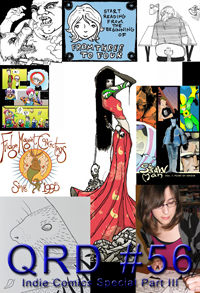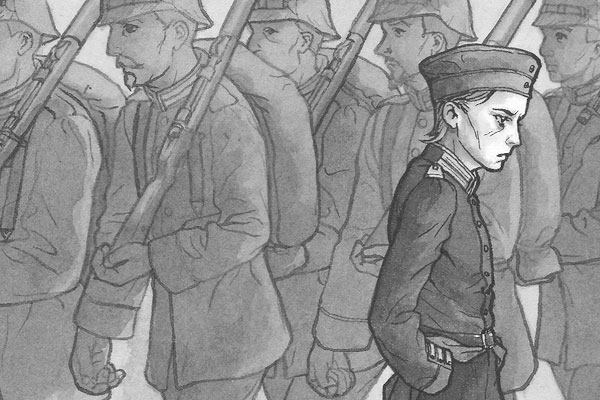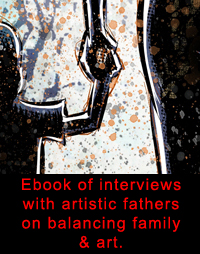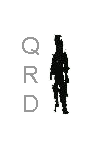
July 2012

City: Columbus, Ohio
Comics: NO ONE IS SAFE; NERVENKRANK
Websites: katherine.kreider-wirick.com, katherinewirick.tumblr.com
QRD – How old were you when you first got into comics & did you always stick with them or did you come back to them?
Katherine – I was about twelve or thirteen, miserably depressed, had gone from tolerably popular at school to a social outcast in under a year… It was the perfect moment for comics. I discovered comics & rock ‘n’ roll at about the same time in my life, which was also when my grades started to drop. Probably just a coincidence.
It’s strange, to me, to read Chris Ware, for whom I should say I have enormous respect, but who associates comics inextricably with deep adolescent shame, insecurity & ostracism. I felt all those things when I was thirteen too, but comics were my liberation. Art - & when I say “art” I mean comic books, pop songs, paintings, movies, I’m not drawing a highbrow/lowbrow boundary here - taught me that I was not alone, that I had a culture, that I had a place in the world. I don’t have comics shame at all. So although Ware is phenomenal I just can’t relate to his work on that level.
Anyway, I’ve never stopped reading comics since middle school, although I had to cut down after I moved to Philadelphia - rent was expensive & I didn’t have disposable income anymore. I did stop making comics for a fairly long time. I got a BFA in illustration, went to grad school, floundered, dropped out, did some graphic design work, cried in my apartment, went to a much better grad school, started painting again…
I love painting in oils. There’s no medium that compares. But I spent about six months on one big painting & all the while this thought kept nagging at me: A painting can only be fully experienced in one place at one time. You can’t properly reproduce paintings. It’s not possible. The limitations of photography & print just don’t allow it. (Except “Les Demoiselles d’Avignon”, which is the only painting in history that looks BETTER in reproduction.) So here I am working my ass off on this image & nobody’s ever going to see it the way it’s supposed to be seen, except people who live in or can travel to a particular city. & that’s a best-case scenario - that’s supposing that a museum buys it & hangs it. Any private citizen with a few thousand bucks could take it home & put it in their dining room & then it’s basically dead to the world. It’s lost. I can’t show that painting to my relatives who live in small towns & don’t travel. But I can send them a book. The one millionth copy of a book is just as real, just as much the thing itself, as the first copy. Reproducible work is inherently democratic & inherently mistrusted in the fine-art world, so that’s two good reasons to do it right there.
QRD – What was the first comic book you ever bought?
Katherine – I think it was probably either an issue of MixxZine or a Sailor Moon tankoubon in Japanese. The first English comic book I ever bought, I think, was Johnny The Homicidal Maniac #3.
QRD – How old were you when you put out your first comic?
Katherine – Around 21 & we shall say no more about it.
QRD – What decade do you think produced the best comics?
Katherine – This one! I think comics are getting better all the time.
QRD – Why comics instead of just writing or drawing?
Katherine – I wrote as a kid & then I found out I could draw & it just seemed natural to do both at the same time. Also, putting words & pictures in the same place at the same time & calling it art makes some people really mad & I enjoy that.
QRD – Do you see mini-comics & indie comics as paths to mainstream comics or as their own unique media?
Katherine – It depends what you mean by “mainstream.” If you mean “widely available & read by lots of people,” like, say, Maus, then the indie scene can be a path to the mainstream & that’s great. If you mean “published by DC & Marvel,” then I don’t think indie & mainstream need have anything to do with one another necessarily.
On the other hand, I love it when indie people play with superheroes, like Kate Beaton drawing Wonder Woman - not in a hip, sneering way, but with joy & enthusiasm. I like seeing women, particularly, say, “Hey, I have a stake in these characters, they belong to me too.” So I’m not saying the two worlds should never touch. I just don’t much want to work for the Big Two.
QRD – How many copies of your comic do you print in your first run?
Katherine – I printed 500 copies of the first NERVENKRANK mini, which was too many. NO ONE IS SAFE was a different animal - the first run was 15 copies, because I was making the books by hand & that was as many as I could get done in time for my graduate thesis show, where the original work premiered.
QRD – How much do you think comics should cost?
Katherine – This is something I’ve been thinking about for a while. I read prose fast & comics faster & the result is that pamphlet comics provide the lowest value for money of any entertainment medium I can think of in terms of how much of my time they occupy. People are always talking about how comics can & should be just as good as novels, movies, etc., but the hard fact is that, for a 24-page comic to be worth $2.99 plus sales tax, they have to be BETTER.
(Mini-comics are different - limited quantities, limited availability, & that factors into the price. I’m willing to pay a lot more per page for a mini off an artist’s table at a con than I am for a monthly comic off the rack at my local comic shop.)
QRD – How many books do you produce a year & how many would you like to?
Katherine – About one, so far. NO ONE IS SAFE took two semesters to do, not including research - about eight months. NERVENKRANK has been very slow work to date, because of how much research goes into it. It’s not necessarily easy to find out what a German wheelchair looked like in 1915 & I like to get those things right. I believe I read that Jason Lutes averaged 28 pages a year on the second volume of Berlin & I’d like to work faster than that, but I don’t know if I’ll be able to.
QRD – Do you think stories should be serialized or delivered as complete works?
Katherine – Every once in a while you get lucky & (let’s say) a TV show you were already watching suddenly shifts into a higher gear & with each new episode you have the feeling that you’re participating in something, that you’re watching art being made before your eyes. The West Wing hasn’t held up as well over the years as I would’ve expected, but I remember watching it with my mother when I was in high school & the run of episodes at the end of season two, from “17 People” to “Two Cathedrals,” was just unbearably exciting to watch when they premiered. Those people were giving you something that nobody had ever seen before.
But I don’t experience a lot of media like that. Generally, I don’t enter into stories until they’re complete. I’m always late to everything. I prefer graphic novels to monthly comics & DVDs to cable subscriptions. I like serialization because it allows people to tell extremely long, decompressed stories & support themselves financially, but I don’t think it has many benefits outside of that. Except when you get surprised by greatness.
QRD – How are comic strips different than comic books & which medium do you prefer?
Katherine – It’s funny how a single drawing & caption that together express a complete thought will still be called a “strip.” I mean, if any given installment of The Far Side is a comic strip, then George Grosz’s “Die Gesundbeter/German Doctors Fighting the Blockade” is a comic strip. It’s just an imprecise term. Of course, no one ever describes that Grosz drawing in funny-pages language, because he was a serious artist (although he yearned to be a famous illustrator & admired Norman Rockwell & almost all of his best work ran with a funny caption underneath it… but I digress).
I can’t say which medium I prefer on an abstract level. It’s like saying, which is better, singles or albums? It depends on the artist. Personally, I don’t make comic strips because I’m longwinded & not funny. Comic strips (of the one-panel or multi-panel kind) are kind of like conceptual art in terms of what it takes to make them - you have to be a master of concision. The idea has to be pared down to its essential elements & each element has to be perfectly chosen, the juxtaposition has to be absolutely right so that the whole object shakes itself to life… Good conceptual art is like that. (There’s a lot of bad conceptual art. There’s a lot of bad comic strips, too.)
QRD – How long is it from when you start a comic until it’s printed?
Katherine – I can’t really answer this; all my projects have been different.
QRD – What do you do better with your comics now than when you first started?
Katherine – Oh, God, everything. I started lettering by hand & even though I’m not a trained letterer, I think it makes a huge difference. Part of that is Lynda Barry’s influence; she talks about writing by hand as conducive to a certain state of mind that allows stories to happen. There are a few comics that have a very slick, computer-aided aesthetic & for them those Blambot fonts are appropriate, but to see artwork that has the idiosyncrasies of the hand in it & then those perfect vector letterforms on top - it drives me crazy. Please, letter your own stuff! You just have to be legible! You don’t have to be Todd Klein!
QRD – At what point in the artistic process do you work digitally?
Katherine – All I do digitally these days is typography on covers & some very basic pre-press on pages. I’m comfortable with Creative Suite & I know how to paint digitally, I just mostly prefer not to. It’s hard on my hand, for one thing; I tend to clench the stylus. Maybe if I had a Cintiq I’d feel differently. Anybody want to buy me a Cintiq?
QRD – What do you think of digital comics & webcomics?
Katherine – I don’t have an e-reader so I can’t really say anything about that, but I love webcomics! Especially because there are so many women making them. Danny Noble on Tumblr, look her up. Angrybeige - I don’t know her real name. Noelle Stevenson. Christiann MacAuley (she runs stickycomics.com). It goes without saying that I love Kate Beaton. I’m also a huge fan of Steve Wolfhard & Nathan O. Marsh. & Toothpaste for Dinner, especially the Columbus jokes.
I really only read strips & very short stories online, though. I just don’t like to read long-form work on a computer. I’ve made a couple of exceptions, like Freakangels & TJ & Amal, but there’s really no story that’s best taken in as chunks of 2-6 pages once a week. Also, the web is just inherently distracting. Print novels don’t have a bunch of icons sitting in the margins.
QRD – Do you prefer working in color or black & white?
Katherine – I think I work in black & white mostly out of fear. Introduce full color & suddenly there are so many variables. It’s more than I can handle most of the time.
QRD – How many different people should work on a comic & what should their jobs be?
Katherine – I’m kind of indie-snobby about this - I feel that the ideal number is one, maximum two. There are some mainstream comics I love that were put together by bigger teams - Swamp Thing, Nextwave - but they’re pretty rare exceptions.
QRD – How do you find collaborators?
Katherine – I don’t. Generally I’m just too wrapped up in my own obsessions to get closely involved in someone else’s. That doesn’t mean it’ll never happen, though.
QRD – How tight do you think a script should be as far as telling the artist what to draw?
Katherine – My scripts tend to be extremely spare, because I’m not writing for another artist. When a friend offers to critique a draft for me, I usually have to do a second pass just to make the panel descriptions less boring for them to read. I know in my head how every panel’s going to look & I don’t need to make a lot of notes for myself. If I were drawing someone else’s script, I think I’d like an Alan Moore level of detail, just to cut down on the number of questions I’d have to ask the writer.
QRD – What comic book person would you be most flattered to be compared to?
Katherine – Art Spiegelman, partly because of his body of work & partly because I’ve met him & he is an incredibly kind & gracious person. He was actually so nice to me that I almost burst into tears.
QRD – What do your friends & family think of your comics?
Katherine – My parents were a little confused at first when I told them I wanted to go to art school, because I didn’t show any particular artistic aptitude until I was fifteen or so. My father actually called up my high school drawing teacher, who is now serving a very long prison term, to ask him if I was any good; but he was too busy committing felonies to learn the names of the kids in his class. My parents are proud now, though. The thing is that the stories I tell in comics aren’t wildly divergent from the stories they enjoy on TV & in books. They’re fact-based historical dramas. So it’s not like my parents have to make a huge leap of imagination to read my comics.
My husband completely supports what I do, but he’s really, really tired of hearing about John Heartfield.
QRD – What do you think of superheroes?
Katherine – I enjoy them when they’re good. I’ll read anything if it’s good. & I’d be a colossal hypocrite if I were to sneer at superheroes as a concept, because I got into comics through Sailor Moon, which is a superhero book with big eyes & sparkly accessories. But I’ve never become an actual fan of any particular character, because this is what always happens: I’ll see some images on the internet & think, “Hmm, Deadpool, maybe I should read that,” so the next time I’m at Barnes & Noble I look for the Deadpool books, but there are eight & they’re indistinguishable from one another & I’ve never heard of any of the writers, & they’re too expensive for me to just grab one & gamble on it being good, so I say the hell with it & buy the next volume of 20th Century Boys. I don’t know where to start with any given superhero & my base interest level never gets high enough to leap that obstacle. Movie adaptations make it so much easier. Interested in Thor? There’s a movie for you. It’s called Thor.
QRD – Marvel or DC?
Katherine – I’m not sure which has less nauseating business practices. But Marvel printed Nextwave, so I’ll pick Marvel.
QRD – What comic characters other than your own would you like to work with?
Katherine – I’d kind of like to do a Captain America story, but it would really be a story about my own frustration with the fact that he’s not real & neither is anything he symbolizes.
QRD – Ideally would you self-publish?
Katherine – I don’t think so, but I can’t really give an informed answer because I don’t have experience with the alternative.
QRD – What conventions do you try to attend & why?
Katherine – I know what I like as a visitor, but when it comes to selling comics I’m still learning what works for me. I’ve done two small cons & one big one so far - SPACE in Columbus, RathaCon in Athens, & Stumptown in Portland - & the small cons have been much better, not just in terms of sales but the overall experience too. But I’m booked to do SPX in September, so I hope the trend doesn’t hold.
QRD – What do you do to promote your books?
Katherine – I use Tumblr a lot, but Tumblr’s huge & it can be hard to make yourself heard. I’m relying more on cons than on the internet right now. The tough thing about that is that merchandise - t-shirts, pins, plushies, etc. - is what grabs a lot of people’s eyes at cons & my books don’t really lend themselves to merchandising. I could make a t-shirt that says “Die Kunst ist tot,” I guess, but I’m not sure it would sell.
QRD – Do you think your comics are well suited to comic shops or would sell better elsewhere?
Katherine – I think NERVENKRANK could sell well in regular bookstores, when it’s finished. I’ve been pleased lately to see comics shelved by subject, not just in the catchall section next to the D&D manuals - 21 in the sports section, PERSEPOLIS in memoir, etc. I’d like to see NERVENKRANK in the art history section, although it’s not a strict biography so that might be too much to ask.
QRD – What other medium would you like to see some of your comics made into (television, film, games, action figures, etc.)?
Katherine – NO ONE IS SAFE was designed for a wall & that’s where it works. The only thing that would draw me to even entertain the thought of translating it into another medium would be the possibility of sound - if it were, say, an animated short, where you could hear “Ohio,” you could hear my father’s voice.
Sometimes I think about NERVENKRANK as a film… but it could easily turn into one of those hideous Oscar-bait prestige pictures, which would be the worst thing.
QRD – Do you consider yourself a comic collector or a comic reader or both?
Katherine – I don’t collect books, in the sense of preserving them against deterioration in hopes that they might be worth money someday. Books come to me pristine & perfect & I unconsciously exert some kind of powerful entropic force that makes covers warp & spines crack & pages dog-ear. Every book I’ve ever owned has had the crap beaten out of it & that goes for comics too.
QRD – What do you see as the most viable mediums for comics distribution 10 years from now?
Katherine – I’m terrible at futurology. My beat is the past, generally speaking.
QRD – What would you like to see more people doing with comics?
Katherine – When I started going to SPX, four years ago, there were a lot of college students there. They’d come in groups, go in together on a table, each bring a mini-comic or two & the presentation wasn’t very polished most of the time, but some of the talent was incredible & the stuff they’d draw was just wild, bound by no rules & beholden to nobody. & every year it seems like there are fewer of those people & more professionals, with logos & websites & business plans. I don’t know if it’s because of the economy or what. & the professionals are great! We need them! I’m one of them! But I miss the students & their grubby cheap punk rock copy-shop comics.
QRD – Anything else?
Katherine – Why was there never a second English volume of Even a Monkey Can Draw Manga? Someone get on that.








